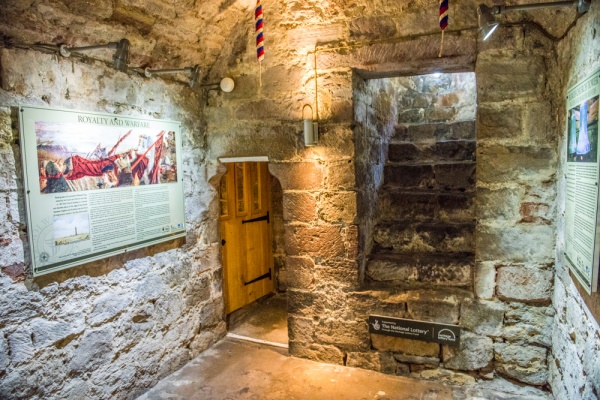
St Michael's church in Burgh-by-Sands is one of the most fascinating historic buildings in the north-west of England, and it is unique in having both an east and a west tower.
The church was probably built in the 12th century, using stones from Hadrian's Wall and the Roman fort at Aballava. Though we do not know exactly when it was built, we do know that the first vicar was called Swein, and that it was supported by an endowment of one acre of land.
Around AD 1200 Hugh de Morville, lord of Burgh, gave the church and land to Holm Cultram Abbey, 12 miles away in Abbeytown.

Edward I at Burgh-by-Sands
In 1307 the aged and ailing King Edward I of England marched north to do battle with Scotland. He reached Burgh-by-Sands on 5 July and camped at Burgh Marsh, just north of the village, in preparation for crossing the Solway. On 7 July Edward died, and the site where he breathed his last was marked by a 'great pile of stones'. It is now marked by a memorial column built in 1685 and rebuilt in 1803.
Edward's body was carried to St Michael's church to lie in state. Edward's son and heir, Prince Edward, came to St Michael's with the royal court to pay homage to his father, and was crowned as Edward II in Carlisle on the following day.
The dead king's funeral cortege proceeded south from Burgh-by-Sands to London, where Edward was buried in Westminster Abbey. After Edward's death, the border region descended into lawlessness. The inhabitants of Burgh-by-Sands, being so close to the Scottish border, were subject to repeated raids.

One of those raids destroyed the manor house in 1339. As a response the inhabitants built a fortified west tower to defend the church and act as a refuge in times of trouble. Stones scavenged from the manor house were set into the tower floor, and the tower is made with large blocks of Roman stone.
Only three fortified church towers remain in Cumbria, and of these, St Michael's tower is the most impressive and best-preserved. The walls are two metres thick, giving the tower the appearance of a castle. The door was placed so that anyone approaching could be watched by defenders through a narrow window in the base of the tower.
At some future point a second tower was erected at the east end. This very unusual placement meant that the chancel has no east window. The walls are nowhere near as thick as the west tower, suggesting that it was intended not for defence, but to provide a dwelling for the parish priest.
After Holm Cultram Abbey was dissolved by Henry VIII at the Reformation the church began to decay. The fortified west tower was still needed, however, as a defence against Border Reivers, intent on stealing cattle and general looting. The tower was fitted with a firing loop so its armed defenders could scare away Reivers with newly invented firearms. The firing loop probably replaced an earlier arrow slit.

The east tower was used a a schoolroom in the 18th century, and the decaying church was completely restored in 1880.
The interior boasts several reminders of its Norman origins. There are two 'beakhead' carvings, one on the north chancel wall and one high on the south wall of the nave. Even more interesting is a tympanum over the west tower door, carved with figures of a bird and a beast that looks like a horse grazing. The tower can only be entered through an iron 'yett', a gridlike gate that would have been augmented by timber bars across the opening.
St Michael's is a fascinating church with an equally interesting history. Its connection with Edward I is what draws most visits, but it deserves a visit for its own sake. The church is usually open daylight hours and was open when we visited.
About Burgh by Sands, St Michael's Church
Address: Burgh-by-Sands,
Cumbria,
England, CA5 6AW
Attraction Type: Historic Church
Location: Six miles north-west of Carlisle. Parking along the road.
Website: Burgh by Sands, St Michael's Church
Location
map
OS: NY328591
Photo Credit: David Ross and Britain Express
HERITAGE
 We've 'tagged' this attraction information to help you find related historic attractions and learn more about major time periods mentioned.
We've 'tagged' this attraction information to help you find related historic attractions and learn more about major time periods mentioned.
Find other attractions tagged with:
NEARBY HISTORIC ATTRACTIONS
Heritage Rated from 1- 5 (low to exceptional) on historic interest
Kirkbampton, St Peter's Church - 2.2 miles (Historic Church) ![]()
Drumburgh Castle - 3.9 miles (Historic Building) ![]()
Carlisle Castle - 4.6 miles (Castle) ![]()
Tullie House Museum - 4.7 miles (Museum) ![]()
Carlisle Cathedral - 4.8 miles (Cathedral) ![]()
Aikton, St Andrew's Church - 4.8 miles (Historic Church) ![]()
Carlisle, St Cuthbert's Church - 4.8 miles (Historic Church) ![]()
Carlisle Guildhall Museum - 4.9 miles (Museum) ![]()
Nearest Holiday Cottages to Burgh by Sands, St Michael's Church:
More self catering near Burgh by Sands, St Michael's Church












